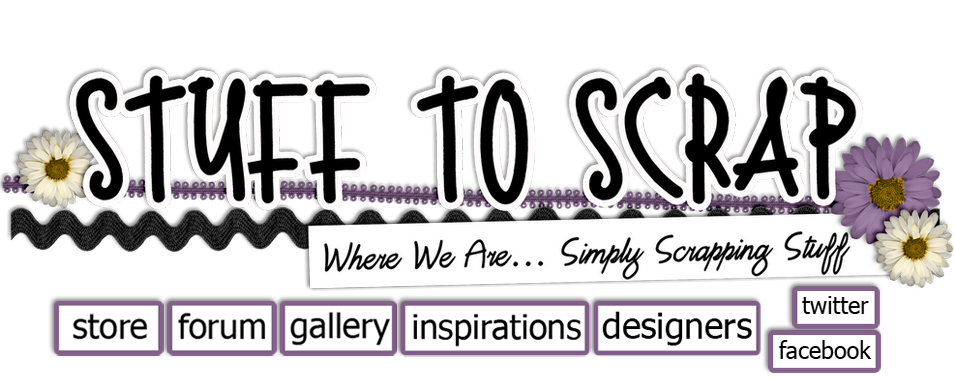
How to Create a Template
Remember, I use Photoshop Elements – so these instructions/tips/tricks may need to be altered to fit your program
* Create a new 12x12 (or 8.5x11) document. Make sure that the background layer is “unlocked” or start with a transparent background) and a solid color. (In PSE you can unlock the background layer by double clicking it and selecting OK)
*Begin adding shapes to your workspace. Base them off of a previous layout you’ve done, or just start plopping them in. I use the rectangle tool and custom shape tools to create most of my shapes, but also have a collection of shapes and shape templates I have created (ex. My Paper Shapes & Paper Borders)
*Arrange the shapes on the page in any way your heart desires. Be sure you have a spot (or more) that’s good for a photo. Layer them, cross them, rotate them….
*Make sure you simplify each shape once you have it set the way you like it.
Trick: Let’s say you want to include a curled string as one of your elements in your template, but don’t know how to draw one. Open up a curled string that you like. Select the string (CTRL/CMD click on the layer in the layers menu in PSE) so that marching ants appear around the edges. Then using a brush paint the selected are a solid color. You now have the “template” for a curled string that will serve as a guide on your template. If you. Be sure you only place the layer with the painted shape and not the actual element.
*Add a spot for a title and/or journaling. Typically, I flatten/simplify my text layers after creating them. If I choose to leave the text editable (sometimes for journaling) I try to use a system/standard font. If the user does not have the font, their computer will likely default to a standard font and it may change the formatting or layout of the text placement.
You can add drop shadows if you want, I usually do not – I leave that up to the template user.
Tip: I suggest going through your layers and renaming them to what the layer represents. “Photo1” “Large Mat” etc. to make it easier for a user to follow your guides.
Once your template is complete and you are ready to save it, be sure to crop it. A lot of times when you rotate or resize pieces they fall off the side of the page. Crop it down to the 12x12 or rectangle size to reduce the file size.
Trick: Another way to create a template is to take an old layout you have done (as long as you didn’t use a template to make it) and use clipping masks to convert each layer to a template form. Place a solid color layer directly above any layer on your layout press CTRL-G (CMD-G) to clip the color to your original layer. Now right click on the color layer and select “merge down.” I don’t like this technique, I prefer to create shapes as described above
THIS IS THE MOST IMPORTANT PART – SAVING YOUR TEMPLATE
Saving your template so that it is usable by other scrappers is key. Saving it as a layered file is important for ease of use. There are two file types that I know of that are layered documents:
PSD (a Photoshop File) and TIFF (similar to a PSD, a high resolution layered file, only it can be used in other programs)
You should also include a full sized flattened version of the template for those who cannot open a layered file. Flatten your image and save it as a JPEG at medium quality for this file. This is used by those who can’t open an editable file as a sketch or guide.
Feel free to ask questions - or leave your own tips in the comments!

8 comments:
Love this idea for the template challenge this month. Going to have to try this one!
thanks for the TUT girl !!! love it.. i definitely have to try this one !!!
great tut - but I would LOVE it if more people included PNG files in their templates for those of us who scrap with different programs :) To do that, you just turn off every layer except one and save as PNG, then do the same for each layer.
I'm so glad you put up this tutorial! I've been wanting to dabble in creating templates, so now I'm extra motivated. =) Thanks!
@jewelgoodwin - I hadn't heard anyone request that after I started including the tiff files. Those don't work in your program? I know that some of the special scrap software can handle layered tiff files. I can start including those too. :) It's a big job to do templates in multiple sizes, formats and styles to please everyone but I want stuff to be able to be used. :)
I cant use layered tiffs - I tend to use those kinds of templates more to 'scraplift'. I know its alot of work and I totally understand if you can't do it - but it never hurts to ask!
Thanks so much for the tut! I have been wanting to learn this technique. I am having trouble understanding the last 2 sentences of your first "trick". I would appreciate some clarification.
Your blog is very nice... i like your blog ....
website design New York City, web designer nyc, web site design, web design
Post a Comment